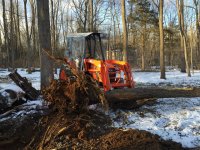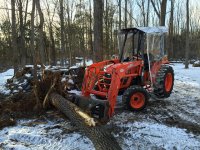gladehound
Veteran Member
I am sorry, I thought you did not.
"The reason I began doubting the validity of this is because the amount of rear ballast most people use is not enough to change the weight on the front axle substantially when a heavy load is lifted. I struggle to believe that a 10% difference in weight on the front axle is going to trash it."
Yes, I still stand by this statement. I should clarify that this statement is only true when lifting near max load with the FEL when that max load is well beyond the pins (like with forks). The exact numbers are from my tractor and others will vary.
I should also note that without a heavy load on the FEL, huge percentage differences of weight on the front axle can be achieved by adding weight on the 3pt. Up to and including lifting the front end which would represent a 100% difference.
Sorry for not being more clear.
Given these clarifications, 3pt balast will certainly reduce wear on the front axle as much of the time it will only carry a fraction of the weight without balast and I've never doubted this.
My concern was actual breakage of the axle housing which is most likely to occur with a heavily loaded FEL and some sort of dynamic force (like a bump or ditch while moving).
My observation is that in this max stress senario, the typical 3pt balast used for large frame CUTs (~1000 pounds) is only removing 500 pounds (in static senario) from the front axle when it is loaded to 6000-7000 pounds. That is a small % difference and I'm hoping there is enough to safety factor in the front axle strength to not break if one doesn't have the recommended (by my owners manual) 1000 pound 3pt
weight.

